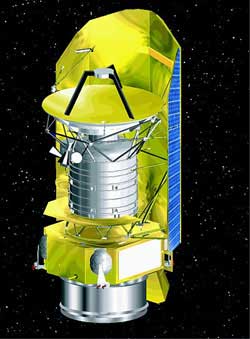Herschel Space Observatory
 Artist's impression of the Herschel Space Observatory |
|
| General information | |
|---|---|
| Organization | ESA |
| Launch date | February 2009 (delayed from July 2007) |
| Deorbited | 2010 or 2011 |
| Mass | 3,300 kg |
| Type of orbit | Lissajous orbit |
| Orbit height | 1.5×106km from Earth (L2 Lagrangian point) |
| Orbit period | 1 year |
| Orbit velocity | 7,500 m/s, 16,800 mph (27,000 km/h) |
| Telescope style | Cassegrain reflector |
| Wavelength | 60 to 670 µm (infrared) |
| Diameter | 3500 mm, f/0.5 |
| Collecting area | 9.6 m² |
| Focal length | 27,000 mm |
| Instruments | |
| HIFI | Heterodyne Instrument for the Far Infrared |
| PACS | Photodetector Array Camera and Spectrometer |
| SPIRE | Spectral and Photometric Imaging Receiver |
| Website | www.esa.int/esaSC/120390_index_0_m.html |
The Herschel Space Observatory ("Herschel") is a European Space Agency (ESA) mission originally proposed in 1982 by a consortium of European scientists that included Thijs de Graauw (Netherlands Institute for Space Research), Gisbert Winnewisser (University of Cologne), Michael Rowan-Robinson (Imperial College, London), Glenn White (Open University and The Rutherford Appleton Laboratory), and Malcolm Longair (University of Cambridge). It is due for launch into orbit sometime in the spring 2009.
The satellite, built in the Cannes Mandelieu Space Center, is due to be carried with the Planck satellite into space by an Ariane 5 ECA rocket. It is then meant to enter a Lissajous orbit of 700,000 km diameter around the second Lagrangian point (L2) of the Earth-Sun system, 1.5 million kilometres distant from the Earth.[1] The mission is named after Sir William Herschel, the discoverer of the infrared spectrum with a joint launch cost of €1.1 billion ($1.7 billion).[1]
Contents |
Instrument
The mission, formerly titled the Far Infrared and Sub-millimetre Telescope (FIRST),[2] will be the first space observatory to cover the full far infrared and submillimetre waveband. At 3.5 meters wide, its telescope will incorporate the largest mirror ever deployed in space.[3] The light will be focused onto three instruments with detectors kept at temperatures below 2 K. The instruments will be cooled with liquid helium, boiling away in a near vacuum at a temperature of approximately 1.4 K. The amount of helium on board the satellite will limit its operational lifetime.
The three detectors on board Herschel will be:[4]
- PACS (Photodetecting Array Camera and Spectrometer), an imaging camera and low-resolution spectrometer covering 55 to 210 micrometres. The spectrometer will have a resolution between 1000 and 5000 and be able to detect signals as weak as a few times 10-18 W/m². The imaging camera will be able to image simultaneously in two bands (either 60-85/85-130 micrometres and 130-210 micrometres) with a detection limit of a few millijanskies.[5]
- SPIRE (Spectral and Photometric Imaging Receiver), an imaging camera and low-resolution spectrometer covering 194 to 672 micrometres. The spectrometer will have a resolution between 40 and 1000 at wavelengths of 250 micrometres and be able to image point sources with brightnesses around 100 millijanskies and extended sources with brightnesses of around 500 millijanskies.[6] The imaging camera has three bands, centered at 250, 350 and 500 micrometres, each with 139, 88 and 43 pixels respectively. It should be able to detect point sources with brightness above 2 millijanskies and between 4 and 9 millijanskies for extended sources.
- HIFI (Heterodyne Instrument for the Far Infrared), a high-resolution spectrograph with a resolution as high as 107.[7] The spectrograph covers two wavelength bands, from 157 to 212 micrometres and from 240 to 625 micrometres.
Science
Herschel will specialise in collecting light from objects in our Solar System as well as the Milky Way and even extragalactic objects billions of light-years away, such as newborn galaxies.
Herschel's scientific goals are:[2]
- To investigate galaxy formation in the early universe and the evolution of galaxies;
- To investigate star formation and its interaction with the interstellar medium;
- To investigate the chemical composition of atmospheres and surfaces of Solar System bodies, including planets, comets and moons;
- To investigate molecular chemistry across the universe.
See also
- BLAST
- IRAS
- COBE
- Infrared Space Observatory
- Spitzer Space Telescope
- AKARI
- Infrared astronomy
- Space telescope
References and notes
- Harwit M. (2004). "The Herschel mission". Advances in Space Research 34 (3): 568–572. doi:.
- ↑ 1.0 1.1 "Herschel Factsheet". European Space Agency (1 February 2007). Retrieved on 2007-09-29.
- ↑ 2.0 2.1 "Herschel". European Space Agency Science & Technology. Retrieved on 2007-09-29.
- ↑ "Herschel Space Observatory". Imperial College. Retrieved on 2007-09-29.
- ↑ "Herschel". European Space Agency. Retrieved on 2007-09-29.
- ↑ "PACS - Photodetector Array Camera and Spectrometer". Retrieved on 2007-09-29.
- ↑ "SPIRE - Spectral and Photometric Imaging Receiver". European Space Agency. Retrieved on 2007-09-29.
- ↑ "HIFI - Heterodyne Instrument for the Far Infrared". European Space Agency. Retrieved on 2007-09-29.
External links
|
|||||||||||||||||||||||